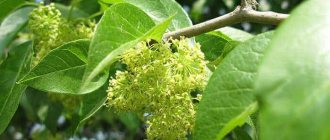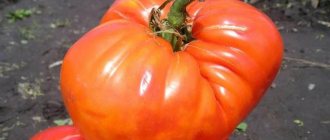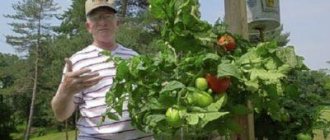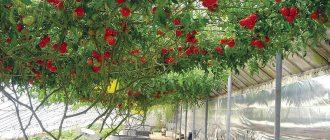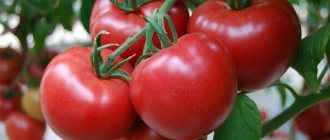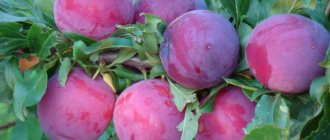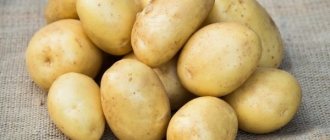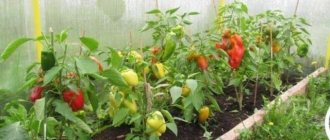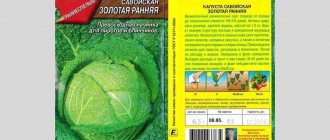In the friendly tomato family, relatively recently, in 2013, a new variety, Strawberry Tree, appeared. Breeders in Siberia developed this delicacy. In 2013, the variety was certified and took its rightful place in the tomato market.
The Strawberry Tree tomato was proposed by the agricultural company Siberian Garden, and in a relatively short period of time (from 2013 to the present day) it has become very popular, judging by the reviews of those who have already planted it. The tree turned out to be impressive, the fruits are very similar to large strawberries. The hybrid is now successfully growing and bearing fruit in many summer cottages and other areas.
Description of tomato Strawberry tree
The Strawberry Tree tomato was bred in 2013 by Russian agro breeders. The plant is indeterminate, its growth is not limited by the appearance of a flower cluster. The variety is a mid-early variety, harvesting begins after 110 days.
Strawberry tree tomatoes are zoned for central Russia; they thrive in greenhouses in the Urals, the Far East and Siberia. In the south of the country, the variety is grown in open ground.
The bushes are powerful, spreading, in an open bed they grow up to 1.5 m. In a greenhouse they stretch up to 2 m. The leaf mass is sufficient, shoot formation is strong, the plant needs shaping and pinching.
The inflorescences are simple, each Strawberry tree bush produces 5-6 clusters. The ovary is formed well.
Description of fruits
According to reviews, Strawberry Tree tomatoes are quite large, as can be seen in the photo. Outwardly, they resemble a large berry - bright red, elongated in shape. The skin of the tomatoes is dense, and when cut, the sugary pulp is visible. Tomatoes of this variety have little juice. Dry matter content up to 12%.
The taste of the Strawberry Tree tomato is excellent. The fruits are moderately sweet, with a hint of sourness.
Important! The average fruit weight of the Strawberry tree is from 150 to 300 g.
Tomatoes “Strawberry Dessert”
The tomato variety that came out of the depths got its name for a reason. Most likely, the breeders were guided by the ancient history of tomatoes, which, by the way, are still classified as both vegetables and berries. The word “tomato” comes to us from the Italian language and means “golden apple”. In turn, the French called tomatoes “love apples,” and the Germans called them “paradise apples.”
Details about the variety
Supporters of the classic types of this crop will be quite satisfied with the qualities of the “Strawberry Dessert” tomato according to the characteristics and description of the variety:
- This is a mid-season indeterminate (not limited in growth) variety, it is recommended to grow it on a trellis or vertical support;
- Harvesting begins in July and can continue until frost, and in heated greenhouses - until early December;
- large ruby-red fruits with small seed chambers, juicy pulp and thin skin have a rounded-flattened shape;
- the taste is distinguished by a sweet richness with fruity nuances;
- The weight of tomatoes, which contain dry matter and sugar, reaches 300 grams, and the harvest from one bush is 10-12 kg.
- even in damp and cool summers, “Strawberry Dessert” is resistant to diseases such as late blight, blackleg, root and apical rot;
- The fruiting period is extended, this allows summer residents to have fresh tomatoes on the table throughout the summer-autumn season.
Chinese date unabi: planting rules and plant care
The disadvantages are few and relate to agrotechnical features:
- When growing this variety, you have to devote a lot of time to pinching and staking the stems in order to provide support for the tall plants.
- The last autumn ovaries can form completely only in protected soil.
- The large size of the fruit is an obstacle to their use as a whole.
Features of cultivation
Since “Strawberry Dessert” is a heat-loving variety, it reacts poorly to temperature changes and even minor frosts
You should pay attention to this when choosing a variety.
The recommended time for sowing seeds is 60 days before planting the seedlings in the greenhouse. This usually happens at the end of March. It must be kept in mind that approximately 85% of seeds germinate.
Seedlings dive after the first true leaf appears
An important condition when growing seedlings is constant supplementary lighting, which will make the plants more hardy.
When planting in a greenhouse, it is necessary to maintain a distance of 40 cm between bushes, and 60 cm between rows. Thickening of plantings is unacceptable, this will lead to a lack of light and fresh air.
A mandatory step is to feed the plants with organic and mineral complex fertilizers every week.
A few days after transplanting the plants into the greenhouse, they should be tied to trellises or supports.
In the greenhouse it is necessary to maintain a constant temperature - not lower than +24 degrees. If the shelter gets sharply cold, the seedlings will stop growing.
Disease and pest control
Even with increased plant resistance to diseases, preventive measures must be taken. They are as follows:
- annual replacement of soil in greenhouses and treating it with a solution of manganese or copper sulfate;
- spraying plants with biological products that have an antifungal effect;
- spraying with a solution of ammonia to repel harmful insects;
- mulching the soil in the greenhouse with a layer of peat or straw to protect plants from root and stem rot.
As practice has shown, if you follow all the recommendations for planting and caring for “Strawberry Dessert” tomatoes, the harvest will certainly please gardeners. Reviews testify to this. Here is one of them:
Victor Kornelyuk, Kazan
Characteristics of the variety
From the characteristics of the Strawberry Tree tomato and the description of the variety, it is clear that the tomatoes are universally used, hardy and high-yielding. The fruits have the ability to ripen quickly during storage.
Productivity and fruiting
According to reviews, Strawberry tree agro tomatoes are highly resistant to temperature changes. The fruits set well, despite the vagaries of the weather and lack of lighting.
Fruiting begins 3 months after planting. Up to 7 clusters are formed on 1 plant, each containing at least 5 tomatoes. This makes it possible to get up to 5 kg of ripe tomatoes from 1 bush. On average, the yield per m2 is about 12 kg.
Important! To get a rich harvest of tomatoes, you need to feed the plants properly.
Area of application of fruits
Strawberry tree tomatoes are suitable for fresh consumption and canning. They make thick juice, purees, and ketchups. The variety is suitable for drying and drying. Some housewives prefer to pickle whole tomatoes.
Resistance to diseases and pests
The Strawberry Tree variety has shown high resistance to diseases such as tobacco mosaic, verticillium wilt, and late blight. However, the bushes are susceptible to brown spot. This disease quite often affects Strawberry Tree tomatoes.
If not properly cared for, tomatoes suffer from greenhouse whiteflies and spider mites.
Advantages and disadvantages of the variety
Over the short period of its existence, the Strawberry Tree tomato variety has accumulated many positive characteristics:
- high productivity;
- presentation of the fruit and heavy weight;
- ability to ripen;
- good tomato taste;
- versatility of use;
- strong plant immunity;
- ability to withstand temperature changes;
- unpretentiousness when growing;
- long fruiting.
No significant shortcomings that would force one to abandon the Strawberry Tree variety have been identified. The only disadvantage of these tomatoes is the need for supports when growing and pinching.
Advantages and disadvantages
The Strawberry Tree tomato has undoubted advantages that distinguish it from many tomato varieties:
- Aesthetic and attractive appearance of the bush and the tomatoes ripening on it.
- High yield, especially in greenhouse conditions.
- Good taste of fruits and versatility of their use.
- Unpretentiousness to growing conditions and diseases.
The only disadvantage, perhaps, is that this tomato requires regular shaping and gartering in order to maintain its unique appearance.
Growing rules
Tomato agricultural technology The strawberry tree is not much different from any tall variety, but it has its own characteristics. The bushes need feeding, but you cannot overfeed them.
Planting seedlings
They begin growing seedlings in mid-February. Seeds are selected in advance and carefully prepared. Untreated seeds can introduce a fungal infection into the soil.
To increase the immunity of seeds and germination, they are soaked in hydrogen peroxide and then sprayed with a solution of potassium permanganate or Fitosporin.
Important! For planting, only full-fledged seeds are used. To select empty ones, they are dipped into a strong saline solution and stirred well. The floating seeds are removed.
The soil for growing Strawberry tree seedlings is chosen to be loose and light. You can make it yourself or purchase it in advance from the store. Purchased soil does not require additional treatment, but homemade substrate is disinfected in any available way.
It is better to grow tomato seedlings in individual containers, but they take up a lot of space, so first sow them in a container. The bottom of the container is well drained with expanded clay or polystyrene foam, a layer of fertile soil is poured on top and planting grooves are formed. Depth - no more than 2 cm. Seeds are laid out at a distance of 2-3 cm and sprinkled with a thin layer of soil.
Before germination, the container with plantings is covered with glass or film for a greenhouse effect. Sprouts will appear on day 5-7, provided that the room temperature is not +20-22°C and the lighting is bright. When the seeds hatch, the glass is removed and the temperature is lowered to +18°C so that the tomato seedlings do not stretch.
Tomato seedlings of the Strawberry Tree variety grow quickly and need proper care. Water the plants carefully so as not to over-moisten the soil. To do this, use warm water. Watering regime 1-2 times a week. If the room is too hot, ventilate it and spray the seedlings with a spray bottle.
Young Strawberry Tree tomatoes are planted in separate containers when a pair of true leaves appear. The same soil is used for replanting. After 2 weeks, the tomatoes are fed with complex mineral fertilizer, which is diluted at half the usual rate.
Transfer
Strawberry tree tomato seedlings are transferred to a permanent place in open ground at the age of 2 months, but they can be planted in a greenhouse 3 weeks earlier. In different regions, the timing of transplantation differs; in the middle zone, transplantation is planned for mid-May, when the night temperature is positive and the threat of frost has passed.
The planting density of plants in the greenhouse and open ground is no more than 3 pcs. per m2. Holes for tall tomatoes are made at a distance of 25-30 cm, row spacing is left up to 50 cm.
Aftercare
Further care for Strawberry Tree tomatoes comes down to regular watering, especially in dry regions. Tomatoes do not tolerate drought well and may drop fruit. Water the bushes several times a week, more often if necessary. In the greenhouse, the soil is moistened every other day.
Important! If you over-moisten the soil, the fruits will be watery and tasteless.
To get a good harvest, Strawberry tree tomatoes are grown in 1 or 2 stems. In the first option, all stepsons are removed throughout the entire growing season. In the second case, 1 shoot is left under the first flower cluster. The stems are directed to a support and tied up.
According to reviews from those who grew Strawberry Tree tomatoes, it was noticed that fertilizing has a good effect on yield. For this variety, complex mineral fertilizers and organic matter are used. Feed several times:
- 14 days after transplantation;
- before flowering;
- during the period of ovary formation.
When the tomatoes begin to fill up, it is better to eliminate mineral fertilizers and switch to organic matter. In this case, nitrates will not accumulate in the fruits.
Landing technology
Tomatoes are most often grown in greenhouses, but they can also grow and bear fruit in open ground.
For greenhouse cultivation, seeds are sown in early March, and for open ground - in early April. Two months after sowing, the seedlings are usually ready for transplanting.
Sowing
Seeds must be soaked before planting
Before sowing, the seeds are soaked in a manganese solution for disinfection. A layer of soil 5-10 cm thick is poured into the tray and the seeds are laid out at intervals of 2 cm.
Then it is moistened with a spray bottle using warm, settled water, and covered with a second layer of soil 0.5-1 cm thick. The tray is covered with film and placed in a warm place, maintaining a temperature of 23-24°C.
Seedling
After 4-5 days, the first shoots appear. Now remove the film and water the sprouts with warm water.
The tray is moved to the windowsill and the temperature is lowered to 16°C (for 5-6 days). When the seedlings form 2 true leaves, they can be planted in separate pots. Two weeks before transplanting into open ground, the plants begin to harden off, taking them outside every day.
Transfer
Before planting, the soil in the garden bed is fertilized, loosened, and irrigated with a manganese solution. You can add ground eggshells and ash into the holes.
The bushes are planted at a distance of 50 cm from each other, having previously installed a trellis for future garter.
Plants are watered with warm water strictly at the root.
Pest and disease control
To prevent diseases, bushes are sprayed with the drug “Ordan”. Treatments are done every 7 days, but they must be stopped 2-3 weeks before harvest.
The preparations “Zaslon” and “Barrier” help well against brown spot. Among the traditional methods, it is worth paying attention to the garlic solution.
To prevent spider mites and whiteflies, the bushes are sprayed with the drug “Confidor”. It is diluted according to the instructions: 1 ml of product per 10 liters of water. This solution is enough for 100 m2.
Important! If there are few pests, then you can get by with traditional methods, for example, a soap solution.
